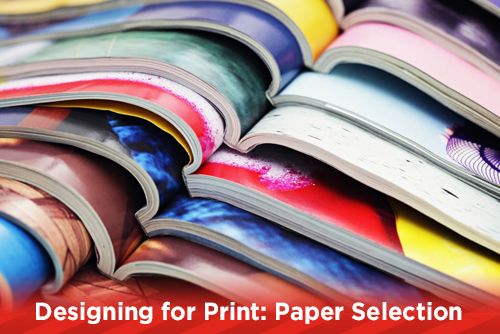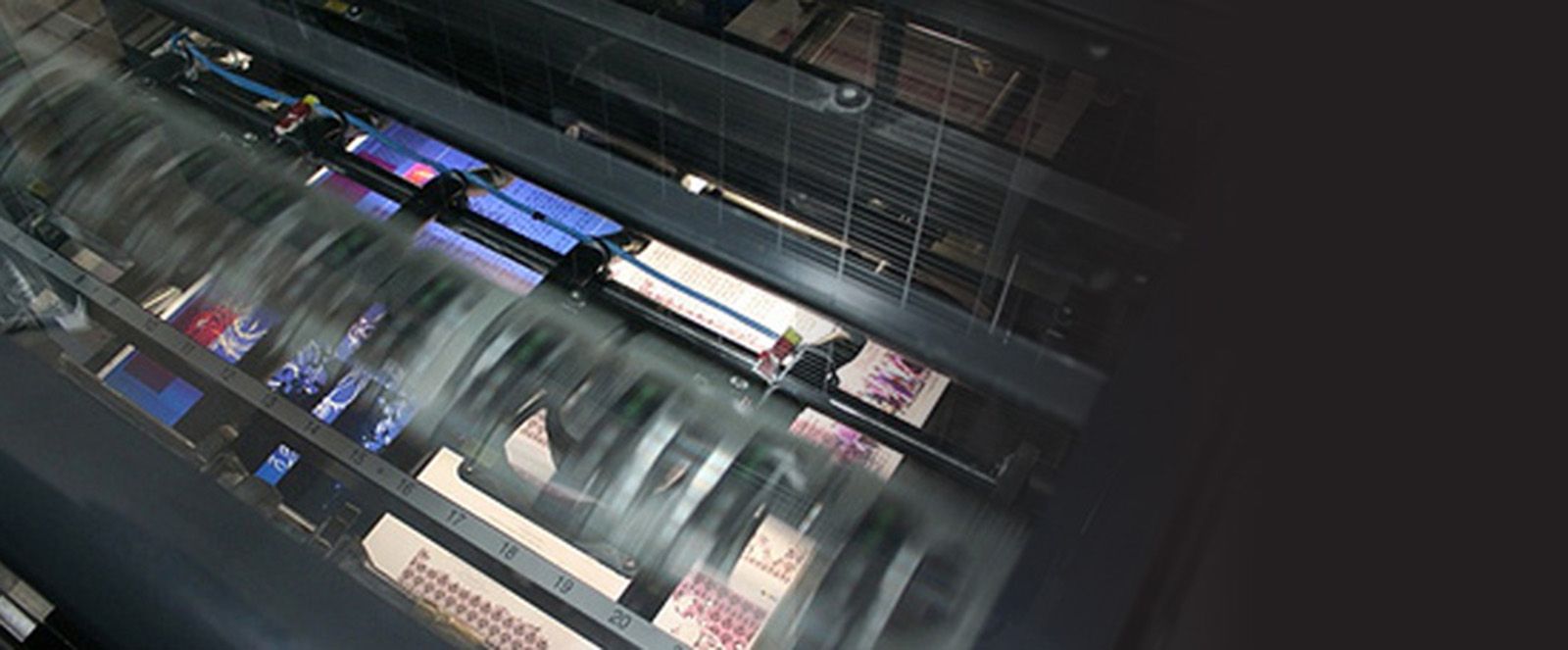
In a previous blog post, 6 Common Choices for the Right Paper Coatings, we looked at specific paper coatings. Today, we’ll take a look at the selection of papers available for your print media projects.
How Paper is Made
The art of papermaking has existed in China since the first century. Eventually it has spread throughout the world and today is a huge industry. Paper is created in two processes: mechanical pulping and chemical pulping. Mechanical pulp is created by mechanically grinding wood chips into pulp reducing it to fibers. Chemical pulp grinds wood chips chemically, reducing the fibers more finely than mechanical pulping. Papers that go through the chemical pulping process are the ones most commonly used for commercial offset printing.
Once the wood has been converted to pulp, the pulp is bleached with chlorine or chlorine compounds, to turn it from a yellowish color to white. Some pulp is bleached without using chlorine for a more environment friendly paper. The pulp is squeezed through rollers and spreads out onto a large felt belt. As the pulp travels along the belt, it is dried and the sheets start to form. Next, the paper goes through a calendar section, which is a set of hard rollers that apply pressure to the paper to create a smooth sheet. The final paper is rolled up and sent to paper distributors, where it is ready to go out to commercial printing companies.
Coated Papers
Papers that have a chemical coating on them are referred to as “Coated Paper”. Most Coated Papers usually have a gloss coating, but gloss is not the only coating available; you can also choose matte, dull and satin coatings.
Matte, dull and satin coated papers a very common in their characteristics. A printing company will sometimes interchange these papers, or even use a common house stock that will meet your requirements, to avoid costing you more money.
Printing on a coated sheet helps your print media project look sharp and clean because the ink sits on top of the paper and does not soak in. A heavier coated sheet is also more opaque than uncoated sheets, so when it is used for two sided prints, you are less likely to see show through from the opposite side. Lighter coated sheets are less opaque so there is more of a chance to see show through.
Some of the downsides to printing on Coated Paper are the ability to write on them with a pen, and the paper may not work well when sent through an inkjet or laser printer. The coating of the paper will not allow the ink from a pen or inkjet printer to soak in and cause smudging.
Uncoated Papers
Just as the name says, Uncoated Papers have no coating on them and are more porous than coated papers. When printed on an uncoated paper, inks will absorb into the paper causing your colors to be more muted than inks printed on a coated paper. Because of this absorption, dot gain, how a halftone dot appears, is more substantial on uncoated papers.
Pantone colors, when printed on an uncoated paper, will not match colors in a Coated Pantone Matching book. The pressman will match the color using the Uncoated PMS book.
Uncoated Papers can also be created with different textures. Laid Paper is an uncoated sheet that has a ribbed texture; Linen Paper has the look and feel of cloth, but the thickness of paper. Textured Paper is any paper other than smooth.
With no coating on the paper, Uncoated Papers are great for letterhead and other print media projects that need to be written on. Other uses for uncoated paper include business cards, flyers and booklet interior pages.
Coated 1 Sided (C1s)
Another commonly used paper, this paper has one side coated with a low gloss coating, and the other side remains uncoated. C1s papers are generally used for postcards that need to be written on one side.
Paper Weights and Thickness
In commercial printing, the weight of a paper is based on the thickness of the paper and is measures in pounds (#) or points (.pt). Papers with a point scale for weight are most commonly cover or card stock. Higher numbers in both means a thicker paper. A 100# coated sheet will be heavier than an 80# coated sheet and the same for a 12pt. sheet being heavier and thicker than a 10pt. Sheet.
GSM (Grams per Square Meter) is another way of specifying the weight of paper. It ranges from 90gsm for ordinary copy paper, to 350 and 400gms for card stock. Many digital printers will have a specific range of the weight of paper it can run. If you request a job to run on a weight of paper that is outside of the parameters of a digital printing machine, then your job may be moved to an offset machine, or you will be asked to reduce the weight of the paper.
Paper Brightness
A papers brightness refers to the amount of blue light that is reflected when a light source measuring 457 nanometers is pointed at the paper at a 45 degree angle. The reflected light is measured and falls between the range of 1-100. A higher number indicates a brighter paper. Common copy paper will have a brightness of 80 whereas an art print paper will be in the 90s.
Paper Whiteness
Another term in paper selections is the whiteness of the paper. This is different from paper brightness. Whiteness is the reflection of all the wavelengths of light in the visible spectrum. When you look at a paper with your eye, they may all look white, but when placed side by side, you will be able to see different color whites. Many white papers have a blue tint to them or a softer yellow tint.
Unless your entire print is covered in ink, brightness and whiteness of the paper will play a role in how your print media project will look. If you have any concerns, ask your print sales person to provide samples of printed material on the paper you are looking to print on.
Paper Grain
In the paper making process, the fibers of the wood will be aligned either vertically or horizontally, thus making the grain of the paper. Knowing which way the grain is aligned on the paper will help you to determine how to print on the paper.
If you have a print project that folds, and you print it to where the fold is against the grain, you end up with cracking along the fold. A heavier paper will make the cracking more noticable. If you print a multi-page book where the grain of the paper is not parallel to the binding of the book, then you could run into the pages not turning easily, wavy paper edges or a bulky binding edge.
If you have a project that requires folds that run both against and with the grain, the project will need to have a score across the fold that goes against the grain. This score will bend the fibers so that they are easier to fold.
There are two directions for the grain to align:
Short Grain
Short grain paper has the grain running parallel to the short edge of the paper.
Long Grain
Long grain paper has the grain running parallel to the long edge of the paper.
How to tell the Grain Direction of Paper
The easiest way is the read the package the paper came in. The second number will be the grain direction (11x17 has the grain along the 17” edge, and 17x11 will have the grain along the 11” edge. You could also tear the sheet vertically and horizontally and compare the tears. The tear with a smoother edge will show the grain direction.
Recycled Paper
Paper made from recycled materials, mainly office waste paper, magazines, and used packaging, are considered Recycled Paper. This paper can also be created from pre-consumer waste fiber such as waste from manufacturing, converting and printing companies. Using recycled paper is less harsh on the environment, but most modern paper companies utilize sustainable and environmentally friendly procedures when manufacturing paper.
Knowing the right paper for your project will help it look and feel great to the end user. If you do not know which paper to choose, ask your printing company sales person to suggest what they think will work. You can also ask for paper samples to see the brightness and thickness of the paper that is suggested.
To see which papers pair nicely with certain projects, download our Print Media Project Paper Guide.
Stay up to date by subscribing to our mailing list.

